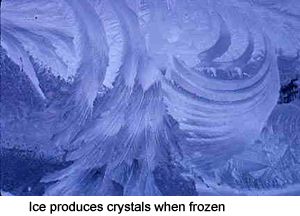BACKGROUND:
 A mineral is a substance that is composed of one or more
elements made from nonliving (inorganic) materials. Minerals can form a
variety of different geometric shapes. If the minerals grow into a
particular shape, they are called crystals. Many students associate the word
"grow" with living organisms. When minerals grow, they become
larger. Some minerals grow into different shapes and have many different
colors. Other minerals have no distinct shapes and only one color.
A mineral is a substance that is composed of one or more
elements made from nonliving (inorganic) materials. Minerals can form a
variety of different geometric shapes. If the minerals grow into a
particular shape, they are called crystals. Many students associate the word
"grow" with living organisms. When minerals grow, they become
larger. Some minerals grow into different shapes and have many different
colors. Other minerals have no distinct shapes and only one color.
Not all crystals are minerals. Minerals must be inorganic
(not living at one time). For example, sugar can form crystals, but it is
not a mineral. Water can form crystals when in its solid state of matter,
but because its natural state on Earth is liquid it is rarely considered a
mineral.
In this lab the students will be looking at the mineral
pyrite. Pyrite, better known as "fool's gold," makes a perfect
cubic crystal and also breaks into cubic shapes. Pyrite is composed of iron
and sulfur. Pyrite has a distinct gold-like color (more brassy than gold,
which is yellowish). The color of a particular mineral may not always be the
same (due to slight variations in the overall chemistry), but the mineral
pyrite is always this golden, brassy color.
Miners would see pyrite in rocks and think it was gold. Gold is denser
than pyrite and has a yellow color, compared to the brassy color of fool’s
gold. Many miners would think they were rich when they found pyrite and when
they came into town bragging about their riches, the other miners would just
say you are a "fool," hence the name "fool's
gold."
PROCEDURE:
- Give students some background information on pyrite. Students are
interested in pyrite because it looks so much like gold.
- Show the students a piece of pyrite and ask them to give you some
descriptions of this mineral. Students will call pyrite "gold
colored." Tell them that gold has a yellow color. You can show them
a piece of gold jewelry to illustrate this. Explain that pyrite is a
brassy color.
- Have the students look at the worksheet. Ask students what shape the
children in the picture are playing on. They will probably use the term
square. Instruct them that the correct shape is cubic because the
crystal is not flat, like a square, but is three dimensional. Show them
examples of squares and cubes in the classroom.
- Pass out samples of pyrite and ask the students to look for cubic
shapes. The mineral pyrite grows in these cubic shapes. Some pyrite has
other crystal forms, but most of the samples you will have are cubic.
- Ask the students to color in the pyrite crystal on the worksheet. If
they don't have a gold crayon, they can use yellow or orange.